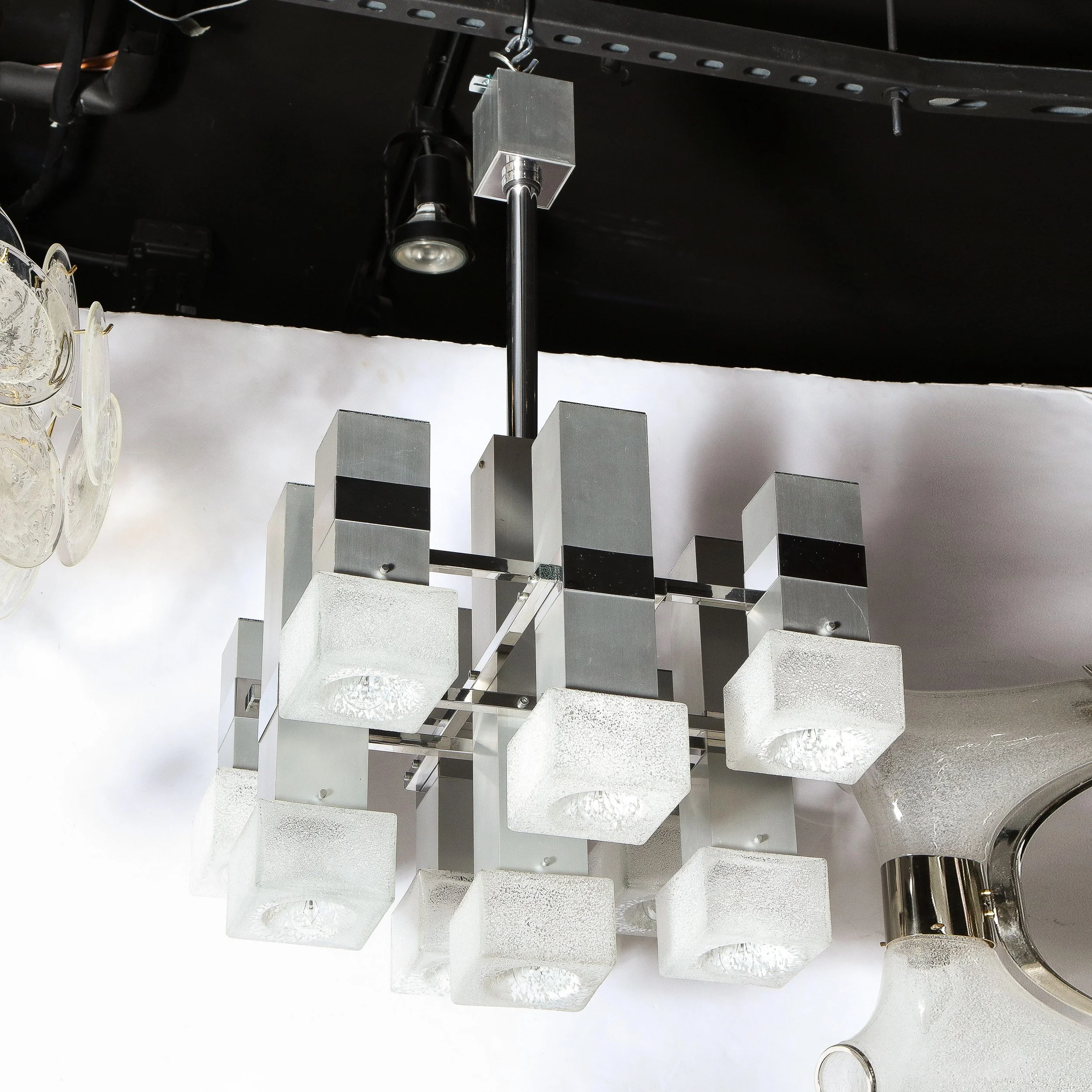Pair of Mid Century Modern 8 Arm Chrome & Mottled Murano Glass Chandeliers by Sciolari












Pair of Mid Century Modern 8 Arm Chrome & Mottled Murano Glass Chandeliers by Sciolari
This stunning pair of Mid Century Modern chandelier was realized by the fabled 20th century designer, Gaetano Sciolari in Italy circa 1970. They offer a grouping of sixteen volumetric rectangular cubic bodies in brushed chrome attached via lustrous chrome supports. The bodies culminate in rectilinear handblown Murano shades with concave centers and expressionistic mottled white detailing throughout the glass, offering an organic counterpoint to the geometric forms expressed elsewhere in the fixture. The chandeliers attach to the ceiling via a polished chrome cylindrical rod and a volumetric rectangular canopy, emphasizing and reiterating a form that appears as a signature element throughout the chandelier. With its iconic Sciolari sensibility- full of verve and elan- this piece is sure to delight discerning collectors of first rate Italian Mid Century design, as well as those with a penchant for exquisite objects. Its clean modernist lines and monochromatic palate ensure that it would be a winning addition to any style of interior from classic Mid Century Modern to contemporary. It has been newly rewired to American standards and is in excellent vintage condition. The height can be adjusted to suit. Each chandelier accommodates eight candelabra based bulbs offering up to 480 watts of light.
Italian, circa 1970
Dimensions:
Height: 38 in. (96.52 cm) Diameter: 22 in. (55.88 cm)
Style: Mid-Century Modern (Of the Period)
Materials and Techniques: Chrome, Murano Glass
Place of Origin: Italy
Period: 1970-1979
Date of Manufacture: circa 1970
Condition: Excellent
Reference Number: LU793444130102
GAETANO SCIOLARI
Gaetano Sciolari, born Angelo Gaetano Sciolari in 1927, was a prominent Italian designer celebrated for his innovative mid-century modern lighting fixtures. Hailing from a family deeply rooted in the lighting industry since 1892, Sciolari's entry into the field was initially unconventional. His career took a significant turn when he assumed control of his family's lighting business following his father's untimely death in 1949.
Before his foray into lighting design, Sciolari pursued architecture and film direction, but the demands of running the family business redirected his path. Under his stewardship, the company thrived and gained international acclaim. By 1954, Sciolari's firm had won an international lighting and design competition, establishing a reputation for innovation and quality. This success paved the way for Sciolari's groundbreaking designs in the 1950s and beyond.
Sciolari began his design career with Stilnovo, an Italian manufacturer renowned for its forward-thinking approach to lighting. During the 1950s, Sciolari's designs stood out for their futuristic vision and technical prowess. His early creations, inspired by atomic themes, featured intricate, multi-light chandeliers made from a mix of glossy and matte metals, capturing the imagination of a world on the brink of space exploration.
The 1960s saw Sciolari shift towards more conventional chandelier forms, but his approach remained decidedly unconventional. His designs were characterized by clean, sculptural lines and a sophisticated blend of materials. The use of brass, chrome, and ice glass in his pieces, combined with satin and polished finishes, created striking visual contrasts that set his work apart. Sciolari's commitment to merging traditional craftsmanship with modern aesthetics resulted in lighting fixtures that were not just functional but also artistic statements.
Sciolari's influence extended beyond Italy as his designs gained popularity in the American market through partnerships with Lightolier and Progress Lighting. During the 1970s, his work was prominently featured in American catalogues, including the Geometric, Habitat, Scultura, and Futura series. The Futura chandelier, with its chrome, brass, and Lucite elements, exemplified Sciolari's innovative approach. This piece, with its futuristic curves and intricate use of mixed metals, became a symbol of modern sophistication and was even showcased in the 1976 Lightolier catalogue.
Sciolari's designs were not only celebrated in homes but also in popular media. His chandeliers graced sets of influential TV shows such as the British sci-fi series "Space: 1999" and the American drama "Dallas" in the 1980s, reflecting the era's glamorous modern living.
In addition to his design work, Sciolari was a pioneering figure in the lighting industry. He founded and served as the first president of the trade association for Italian lighting manufacturers, a role that underscored his leadership and commitment to the industry. His collaborations with manufacturers such as Stilnovo, Boulanger in Belgium, and Stilkronen in Germany further cemented his status as a leading figure in lighting design.
Gaetano Sciolari passed away in 1994, leaving behind a legacy of exceptional design. His work remains highly sought after by collectors and enthusiasts, reflecting the enduring appeal of his visionary approach to lighting. Sciolari's creations continue to illuminate spaces with their timeless elegance and innovative flair, making him a celebrated icon in the history of modern lighting design.
